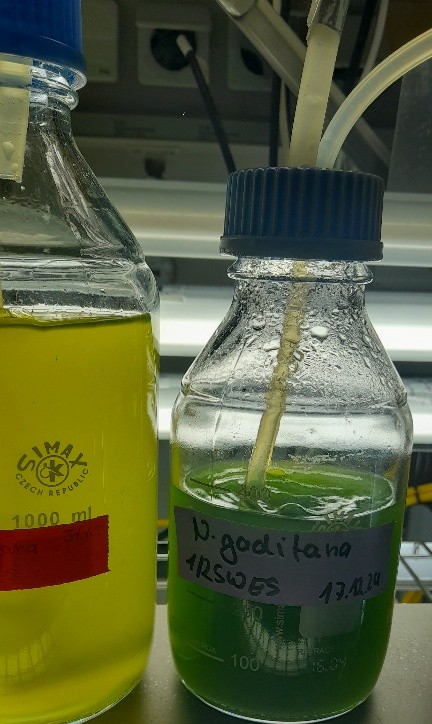Life Sciences
Production of omega-3 fatty acids from microalgae
Together with the companies Roval GmbH and Henry Lamotte Oils, a process chain for the extraction of the omega-3 fatty acid EPA (eicosapentaenoic acid) from microalgae is to be developed. To this end, promising microalgae species are being investigated at Bremerhaven University of Applied Sciences and tested in large-scale production at the project partner Roval GmbH. After selecting and optimizing the algae production, EPA will be extracted and a marketable product developed.
Funding
Funding Body
European Agricultural Fund for Rural DevelopmentFunding Code
EIP-2024-17Funding Amount
470.000 €Duration
01.07.2024 – 30.06.2027
ECOmaterials
Roval GmbH, Ostereistedt, Niedersachsen, Deutschland
Background and goals
icosapentaenoic acid (EPA), a long-chain omega-3 fatty acid, has considerable health benefits, including protection of the cardiovascular system and anti-inflammatory effects. The biosynthesis rate of these fatty acids is low in humans, so that certain groups of people, such as pregnant women, breastfeeding mothers, children and adolescents, and athletes, have a higher requirement and should be supplied with EPA in their diet. Omega-3 fatty acids are often added to food and animal feed to cover the daily requirement. Traditionally, EPA is derived from fish oil, but increasingly microalgae are being used as a sustainable and scalable alternative that avoids the environmental problems of overfishing and enables customized production through controlled cultivation systems. Despite these advances in algae production, challenges such as scalability, extraction costs and product stability still stand in the way of commercial use.
This is where the Algae EPA cooperation project comes in. The aim of the project is to establish an EPA production process using microalgae at the Roval GmbH production facility in northern Germany. The temperature and light conditions in this area fluctuate seasonally, making it difficult to achieve stable biomass and product yields with a single strain of algae. Part of the project is therefore to find a suitable winter and summer algae strain. The selected species include Phaedactylum tricornutum, Nannochloropsis oculata and Microchloropsis gaditana.
Lipid production will be studied under different nutrient and light conditions in order to make recommendations for the production system. The producers' bulk chemicals and the natural environment will be used as a starting point and adapted if necessary. The selected strains will be tested on an industrial scale by the project partner Roval GmbH. After the selection and optimization of the algae production, a marketable EPA product will be developed.
